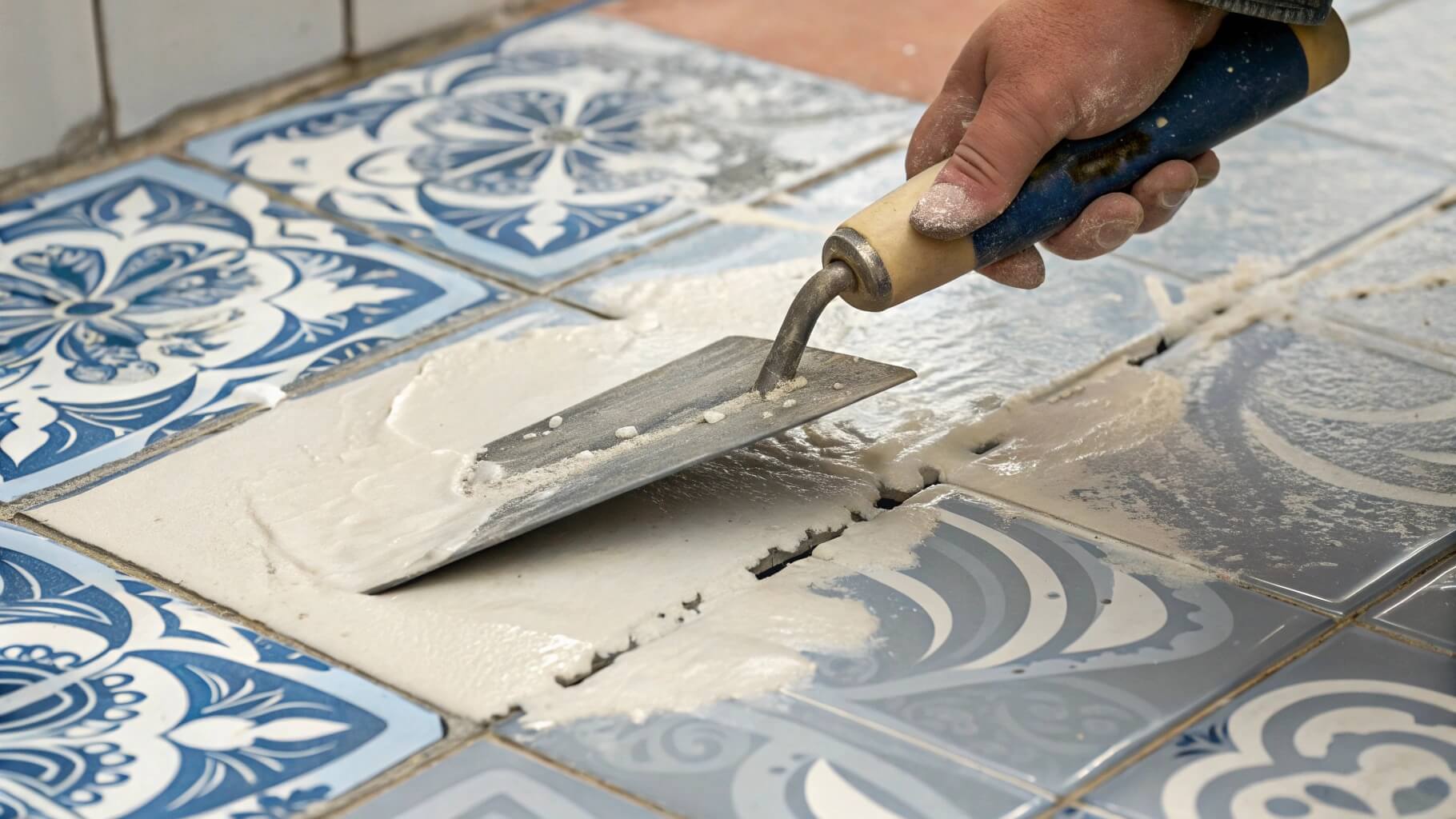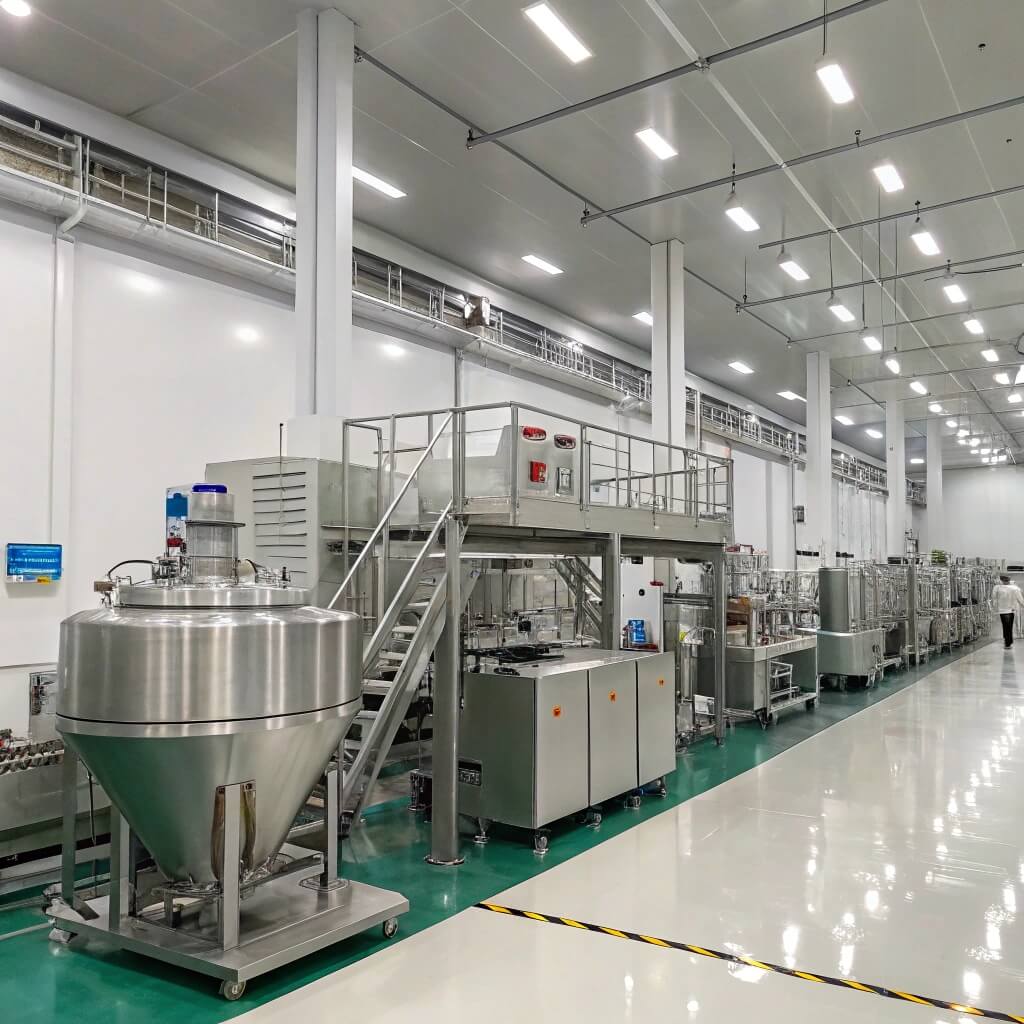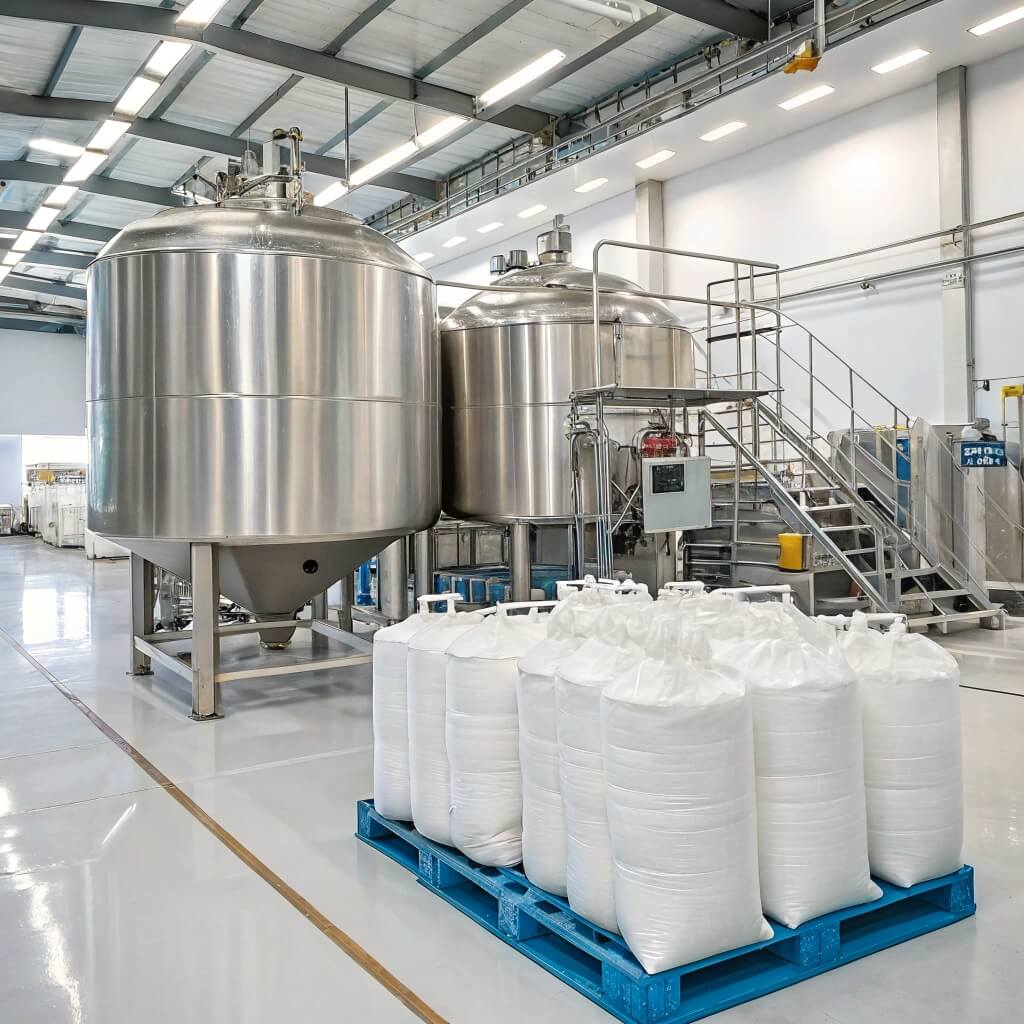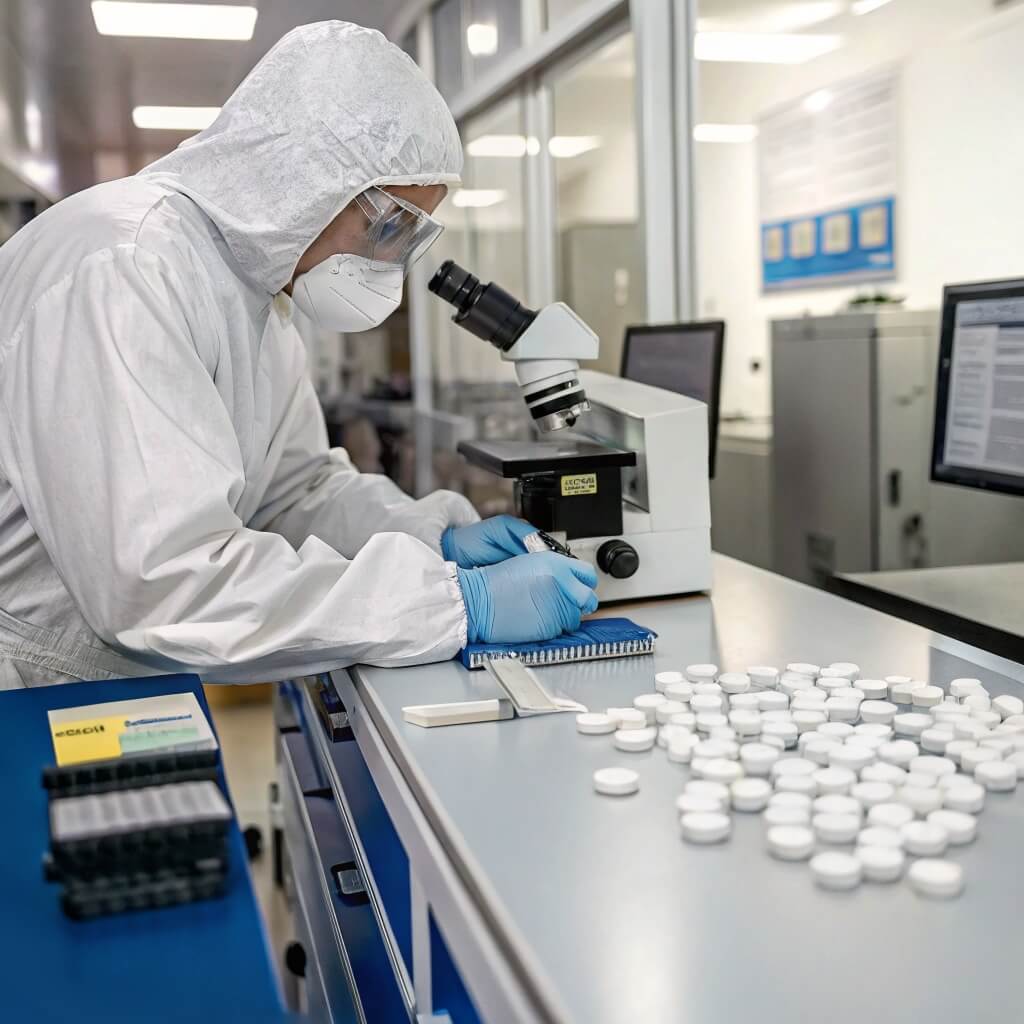Tile adhesives must offer strong adhesion, water retention, and workability to ensure durable tile installation. However, without the right additives, these adhesives can suffer from poor bonding strength, rapid drying, and inconsistent application performance.
Hydroxypropyl Methylcellulose (HPMC) is a crucial additive in tile adhesives, improving adhesion, workability, water retention, and open time. It enhances the consistency and durability of cement-based tile adhesives, making them easier to apply while ensuring long-lasting performance.

HPMC modifies tile adhesive properties, improving workability, water retention, and bonding strength.
To understand why HPMC is essential in tile adhesives, we will explore its function, benefits, and role in optimizing formulation performance.
What is HPMC and Why is it Used in Tile Adhesives?
Fliesenkleber müssen strong bonding, water retention, and ease of application to ensure proper tile installation. However, achieving these properties requires the use of specialized additives. Without them, adhesives can dry too quickly, lack flexibility, or fail to hold tiles securely in place.
Hydroxypropyl Methylcellulose (HPMC) is a key additive in tile adhesives, acting as a thickener, water retention agent, and workability enhancer. It improves adhesion strength, extends open time, and ensures a smooth application process.
Key Functions of HPMC in Tile Adhesives
| Funktion | Benefit to Tile Adhesives |
|---|---|
| Wassereinlagerungen | Prevents rapid moisture loss, improving adhesion to tiles. |
| Verdickungsmittel | Enhances workability and prevents sagging on vertical surfaces. |
| Improved Open Time | Extends the period during which tiles can be adjusted. |
| Enhanced Adhesion | Ensures strong bonding between tiles and substrate. |
| Slump Resistance | Prevents tile displacement, especially on walls. |
Why HPMC is Essential in Tile Adhesives
HPMC improves the rheologische Eigenschaften of cement-based adhesives, making them easier to mix and apply. It prevents water from evaporating too quickly, which is crucial for proper cement hydration and adhesion strength. Without HPMC, tile adhesives may dry unevenly, leading to weak bonding and tile detachment over time.
HPMC in Different Tile Adhesive Types
- Standard Cement-Based Adhesives – Ensures smooth consistency and prolonged working time.
- Flexible Tile Adhesives – Enhances elasticity to prevent cracking due to substrate movement.
- High-Performance Tile Adhesives – Improves water retention for extreme environmental conditions.
The role of HPMC in tile adhesives extends beyond simple thickening—it directly influences adhesion strength, durability, and usabilityDer nächste Abschnitt untersucht how HPMC enhances tile adhesive performance in real-world applications.
Wie verbessert HPMC die Leistung von Fliesenkleber?
Tile adhesive performance is crucial for long-lasting tile installations. Without the right formulation, adhesives can dry too fast, lose strength, or fail to hold tiles securely in place. This can lead to installation failures, tile detachment, or weak bonding im Laufe der Zeit.
HPMC enhances tile adhesive performance by improving water retention, workability, adhesion strength, and open time. It ensures consistent application, prevents premature drying, and increases durability, making it a key ingredient in cement-based adhesives.
Key Performance Benefits of HPMC in Tile Adhesives
| Leistungsfaktor | HPMC’s Contribution |
|---|---|
| Wassereinlagerungen | Prevents premature drying, allowing proper cement hydration. |
| Verarbeitbarkeit | Ensures smooth and even application without lumps. |
| Verlängerung der Öffnungszeit | Allows more time for tile adjustment before setting. |
| Verbesserte Haftung | Enhances bonding strength between tiles and the substrate. |
| Slump Resistance | Prevents tile slippage, especially in vertical applications. |
Water Retention: Preventing Premature Drying
One of the most critical functions of HPMC is Wassereinlagerungen. Cement-based adhesives require adequate moisture for proper hydration and curing. Without sufficient water, cement particles do not fully react, leading to weak adhesion and brittle bonding.
HPMC helps by:
- Slowing water evaporation, ensuring full cement hydration.
- Enhancing curing efficiency, preventing cracks and shrinkage.
- Maintaining bond strength, even in hot or dry conditions.
Improving Workability for Consistent Application
HPMC fungiert als Verdickungsmittel, improving the viscosity and texture of tile adhesives. This prevents segregation of components, allowing for:
- Easier spreading and troweling.
- Smooth, lump-free application.
- Consistent adhesive coverage for strong bonding.
Extending Open Time for Tile Adjustment
Der Offene Zeit refers to how long an adhesive remains workable after application. HPMC ensures longer open time, giving tile installers more flexibility to:
- Adjust tile positioning without loss of adhesion.
- Work on larger areas before the adhesive sets.
- Reduce tile misalignment issues.
Enhancing Adhesion Strength and Slump Resistance
Für vertical tile installations, tile slippage is a common problem. HPMC provides slump resistance, ensuring that tiles stay in place until the adhesive fully sets. It also:
- Increases bonding power between tile and substrate.
- Enhances durability, reducing the risk of tile detachment over time.
- Works well with different tile materials, including ceramic, porcelain, and stone.
HPMC ist a critical additive in tile adhesives, Bereitstellung better water retention, extended working time, improved bonding strength, and superior application consistencyDer nächste Abschnitt untersucht the science behind HPMC and its interaction with cement-based formulations.
The Science Behind HPMC in Tile Adhesive Formulations
Tile adhesives rely on a precise balance of chemical interactions[^1] to achieve optimal performance. Without the right additives, these formulations can suffer from rapid drying, weak bonding, and inconsistent workability. Understanding the scientific role of HPMC in tile adhesives helps explain why it is a critical ingredient.
[^1]: Understanding these interactions is essential for optimizing tile adhesive performance; this resource will clarify those concepts.
HPMC functions as a water retention agent, rheology modifier, and adhesion enhancer in tile adhesives. It influences cement hydration, improves viscosity, and stabilizes the adhesive structure, ensuring stronger bonds and better durability.
How HPMC Interacts with Cement-Based Tile Adhesives
| Scientific Property | Auswirkung auf Fliesenkleber |
|---|---|
| Wassereinlagerungen | Prevents moisture loss, allowing full cement hydration. |
| Viskositätskontrolle | Ensures even distribution and prevents component separation. |
| Surface Tension Reduction | Enhances wetting ability for better substrate adhesion. |
| Filmbildung | Creates a protective layer to prevent early water evaporation. |
| Thixotropic Behavior | Improves application consistency and prevents sagging. |
Water Retention: A Critical Factor in Cement Hydration
Cement undergoes a hydration reaction when mixed with water, forming calcium silicate hydrate (C-S-H), which gives adhesives their strength. HPMC:
- Regulates water availability, ensuring full hydration.
- Prevents rapid moisture loss, which can weaken bonding.
- Enhances final adhesive strength and flexibility.
Without proper water retention, cement particles do not fully react, leading to weak, brittle, and unreliable bonding.
Viscosity Control: Ensuring Uniform Adhesive Structure
HPMC controls the viscosity and flow properties of tile adhesives, preventing segregation of solid particles. This ensures:
- Consistent adhesive coverage across surfaces.
- Smoother application with improved spreadability.
- Better adhesion to both tiles and substrates.
Surface Tension Reduction: Strengthening Bonding Ability
HPMC lowers the surface tension of water within tile adhesives, allowing the mixture to better penetrate and bond to surfaces. This:
- Enhances adhesion strength on porous substrates.
- Improves wetting ability, ensuring even tile coverage.
- Reduces shrinkage cracks, preventing adhesive failure.
Film Formation: Protecting Against Early Water Loss
As HPMC dissolves in water, it forms a thin protective film, slowing down evaporation and ensuring gradual cement curing. This helps:
- Extend open time, allowing for tile adjustment.
- Reduce premature hardening, preventing dry-out issues.
- Improve durability, ensuring a long-lasting bond.
Thixotropic Behavior: Preventing Slump and Tile Displacement
HPMC gives tile adhesives thixotropic properties, meaning they:
- Remain stable while at rest, preventing tile slippage.
- Flow smoothly when applied, allowing easy troweling.
- Regain structure once applied, ensuring tiles stay in place.
Why Understanding HPMC Science Matters for Buyers
Das Recht HPMC formulation directly influences tile adhesive performance. Choosing low-quality or inconsistent HPMC kann zur Folge haben:
- Unstable adhesive consistency
- Poor bonding and tile detachment
- Shorter open time and difficult application
Mit the right HPMC formulation, tile adhesives achieve better water retention, enhanced adhesion, improved application stability, and extended workabilityDer nächste Abschnitt untersucht how HPMC compares to other cellulose ethers in tile adhesive applications.
HPMC vs. Other Cellulose Ethers: Which is Best for Tile Adhesive?
Fliesenkleber benötigen precise formulation adjustments to achieve optimal bonding, water retention, and workability. While Hydroxypropylmethylcellulose (HPMC) is the most commonly used cellulose ether in tile adhesives, other cellulose derivatives such as Hydroxyethyl Methylcellulose (HEMC) and Hydroxyethyl Cellulose (HEC) are also available. Each has unique properties that affect adhesive performance differently.
HPMC offers superior water retention, workability, and adhesion strength, making it the preferred choice for tile adhesives compared to other cellulose ethers. Its balance of thickening ability, open time extension, and anti-slump properties ensures better application results.
Comparison of HPMC vs. Other Cellulose Ethers
| Eigentum | HPMC | HEMC | HEC |
|---|---|---|---|
| Wassereinlagerungen | Hoch | Mäßig | Niedrig |
| Thickening Effect | Hoch | Mäßig | Hoch |
| Slump Resistance | Exzellent | Gut | Poor |
| Verlängerung der Öffnungszeit | Lang | Mäßig | Kurz |
| Verarbeitbarkeit | Smooth | Gut | Sticky |
| Temperature Resistance | Hoch | Höher | Niedrig |
| Bester Anwendungsfall | Standard & premium tile adhesives | High-temperature adhesives | Paints, coatings |
Why HPMC is Preferred for Tile Adhesives
-
Superior Water Retention
- Stellt sicher slow water evaporation, wodurch proper cement hydration.
- Reduces risk of weak bonding due to premature drying.
- Kritisch für hot or dry climates where rapid moisture loss can occur.
-
Better Slump Resistance
- Verhindert tile displacement, especially in vertical applications.
- Keeps adhesives stable during application, ensuring consistent bonding.
-
Verlängerte Offenzeit
- Allows for longer working time before setting, making tile placement more manageable.
- Reduces stress for installers, preventing improperly placed tiles.
-
High Compatibility with Cement-Based Adhesives
- Works well with standard and modified cement formulations.
- Stellt sicher consistent viscosity and smooth application.
When Should Other Cellulose Ethers Be Used?
- HEMC is more temperature-resistant, making it useful for applications requiring high heat stability.
- HEC has strong thickening properties but is less effective at water retention, wodurch es besser geeignet ist für paints and coatings rather than tile adhesives.
Key Considerations for Buyers
- For cement-based tile adhesives, HPMC provides the best balance of adhesion, workability, and open time.
- HEMC is a good alternative for extreme heat conditions but may not retain water as efficiently as HPMC.
- HEC is not ideal for tile adhesives due to its lower water retention and slump resistance.
Die Wahl des richtigen cellulose ether impacts adhesive quality, ease of application, and durabilityDer nächste Abschnitt untersucht HPMC procurement and market trends in the tile adhesive industry to help buyers make informed purchasing decisions.
HPMC Procurement and Market Trends in the Tile Adhesive Industry
Der demand for Hydroxypropyl Methylcellulose (HPMC) in tile adhesives continues to grow as construction projects expand globally. However, sourcing high-quality HPMC at competitive prices requires careful evaluation of suppliers, production capacity, and market fluctuations.
HPMC procurement for tile adhesives is influenced by raw material availability, regional production hubs, global supply chain trends, and price fluctuations. Buyers must consider supplier reliability, quality consistency, and long-term sourcing strategies to secure a stable supply.
Key Factors Affecting HPMC Procurement
| Faktor | Auswirkungen auf die Beschaffung |
|---|---|
| Rohstoffkosten | Fluctuations in cellulose prices affect HPMC pricing. |
| Supplier Location | Proximity to major markets reduces shipping costs. |
| Produktionskapazität | Large-scale manufacturers ensure bulk availability. |
| Global Regulations | Einhaltung von ISO, USP, EP, JP und REACH affects importability. |
| Market Demand | Growth in construction boosts demand for high-quality HPMC. |
Major HPMC Production Hubs
Die HPMC-Produktion konzentriert sich auf China, Deutschland, Japan und Indien, with China being the largest global supplier.
- China: Cost-effective production, large-scale manufacturers, and strong supply chains.
- Germany & Japan: High-purity, pharmaceutical-grade HPMC with premium pricing.
- India & Turkey: Emerging markets with lower costs but variable quality consistency.
Pricing Trends and Supply Chain Challenges
HPMC prices fluctuate due to:
- Raw material shortages affecting cellulose supply.
- Increased demand in construction and pharmaceutical industries.
- Logistics disruptions impacting shipping and delivery timelines.
How Buyers Can Secure Reliable HPMC Supply
- Work with certified manufacturers um sicherzustellen gleichbleibende Qualität.
- Lock in long-term contracts to stabilize pricing and availability.
- Diversify supplier sources to reduce dependence on a single region.
- Request batch testing reports to verify viscosity and purity before bulk orders.
Future Market Outlook
- Growing urbanization and infrastructure projects will increase HPMC demand in Fliesenklebern.
- Sustainable and eco-friendly formulations will drive new product innovations.
- Advances in HPMC modification will enhance performance and cost-efficiency.
Securing a stable HPMC supply is critical for tile adhesive manufacturers looking to maintain quality and production efficiency. The next section summarizes the importance of HPMC in tile adhesives and what buyers should prioritize when selecting suppliers.
Conclusion: The Importance of HPMC for Tile Adhesives
Die Wahl des richtigen Hydroxypropylmethylcellulose (HPMC) for tile adhesives is essential for achieving strong adhesion, water retention, and ease of application. Without HPMC, cement-based adhesives would suffer from premature drying, weak bonding, and inconsistent workability, was zu installation failures and reduced durability.
A high-quality HPMC formulation bietet better open time, improved adhesion strength, enhanced workability, and superior slump resistance, ensuring that tiles remain securely in place. Manufacturers and buyers must prioritize certified, reliable suppliers to avoid inconsistencies and production issues.
Key Takeaways for Buyers
| Faktor | Warum es wichtig ist |
|---|---|
| Wassereinlagerungen | Prevents premature drying, allowing full cement hydration. |
| Haftfestigkeit | Ensures long-lasting bonding between tiles and substrates. |
| Verlängerte Offenzeit | Allows for tile adjustment before setting. |
| Verarbeitbarkeit und Konsistenz | Improves ease of application and prevents material separation. |
| Lieferantenzuverlässigkeit | Ensures consistent quality and stable bulk supply. |
Final Checklist for HPMC Procurement
✔ Verify supplier certifications (ISO 9001, USP, EP, JP) for consistent quality.
✔ Request batch testing reports um sicherzustellen viscosity and purity consistency.
✔ Consider regional sourcing strategies to optimize pricing and supply chain stability.
✔ Evaluate HPMC performance in small-scale trials before committing to bulk orders.
Die Wahl des richtigen HPMC supplier ensures a stable, high-performance tile adhesive. If you're looking for a reliable HPMC manufacturer, contact us to discuss Großbestellungen, Musterprüfungen und kundenspezifische Formulierungen for your specific tile adhesive applications.
Häufig gestellte Fragen
Wozu dient HPMC in Fliesenkleber?
HPMC wird in Fliesenkleber verwendet, um improve water retention, adhesion strength, workability, and open time. It ensures that the adhesive remains moist long enough for proper cement hydration, Verhinderung cracks, weak bonding, and premature drying. It also enhances slump resistance, preventing tile displacement on vertical surfaces.
Welcher Kleber eignet sich am besten für Fliesenkleber?
The best tile adhesive depends on the tile type, substrate, and application method. Cement-based tile adhesives with HPMC additives are widely preferred for their strong bonding, flexibility, and durability. For specific applications, Klebstoffe auf Epoxidbasis Angebot high resistance to moisture and chemicals, während polyurethane adhesives are used for nicht poröse Oberflächen.
What is HPMC used for?
HPMC wird verwendet in construction, pharmaceuticals, food production, cosmetics, and coatings. Its primary functions include thickening, water retention, film formation, and improving adhesion properties. In Konstruktion, it enhances tile adhesives, cement mortars, and gypsum-based plasters. In Pharmazeutika, it is used in tablet coatings and controlled drug release formulations.
Is hydroxypropyl methylcellulose safe to use?
Yes, HPMC is considered safe for use in construction, food, and pharmaceutical applications. It is non-toxic, biodegradable, and classified as Generally Recognized as Safe (GRAS) by the FDA. In pharmaceuticals and food, it serves as a plant-based alternative to gelatin. In construction, it is chemically stable and does not pose health risks when handled properly.




